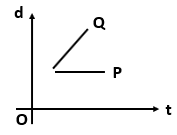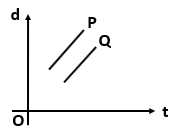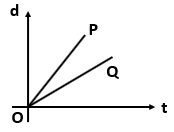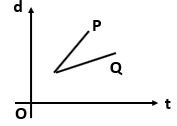A passenger arriving in a new town wishes to go from the station to a hotel located \(10~\text{km}\) away on a straight road from the station. A dishonest cabman takes him along a circuitous path \(23~\text{km}\) long and reaches the hotel in \(28~\text{min}.\) The average speed of the taxi is:
1. \(30~\text{km/h}\)
2. \(49.3~\text{km/h}\)
3. \(55.6~\text{km/h}\)
4. \(60~\text{km/h}\)
1. \(30~\text{km/h}\)
2. \(49.3~\text{km/h}\)
3. \(55.6~\text{km/h}\)
4. \(60~\text{km/h}\)
A car moves with a speed of \(60\) km/h for \(1\) hour in the east direction and with the same speed for \(30\) min in the south direction. The displacement of the car from the initial position is:
| 1. | \(60\) km | 2. | \(30 \sqrt{2}\) km |
| 3. | \(30 \sqrt{5}\) km | 4. | \(60 \sqrt{2}\) km |
| 1. | zero velocity. | 2. | zero acceleration. |
| 3. | non-zero velocity. | 4. | non-zero acceleration. |
If a particle is moving along a straight line with increasing speed, then:
| 1. | its acceleration is negative. |
| 2. | its acceleration may be decreasing. |
| 3. | its acceleration is positive. |
| 4. | both (2) & (3) |
When the velocity of a body is variable, then:
| 1. | its speed may be constant |
| 2. | its acceleration may be constant |
| 3. | its average acceleration may be constant |
| 4. | all of the above |
A particle moves with velocity \(v_1\) for time \(t_1\) and \(v_2\) for time \(t_2\) along a straight line. The magnitude of its average acceleration is:
1.
2.
3.
4.
A body is projected vertically in the upward direction from the surface of the earth. If the upward direction is taken as positive, then the acceleration of the body during its upward and downward journey is:
| 1. | Positive, negative | 2. | Negative, negative |
| 3. | Positive, positive | 4. | Negative, positive |
A car travelling at a speed of \(30\) km/h is brought to rest at a distance of \(8\) m by applying brakes. If the same car is moving at a speed of \(60\) km/h, then it can be brought to rest with the same brakes in:
1. \(64\) m
2. \(32\) m
3. \(16\) m
4. \(4\) m
A balloon starts from the ground from rest with an upward acceleration of \(2\) m/s2. After \(1\) sec, a stone is dropped from it. The time taken by the stone to strike the ground is approximately:
| 1. | \(0.3\) s | 2. | \(0.7\) s |
| 3. | \(1\) s | 4. | \(1.4\) s |
Which one of the following displacement-time graph represents two moving objects \(P\) and \(Q\) with zero relative velocity?
| 1. |  |
2. |  |
| 3. |  |
4. |  |






